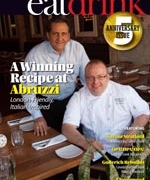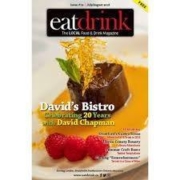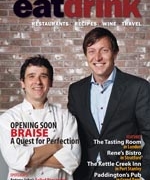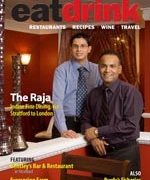Living La Vida Local
I recently travelled south to sample the flavours of Ecuador. But it wasn’t nearly as far as you might expect, not as far as the country itself in the northern part of South America, but a mere 60-minute drive southwest of London. With a Spanish name to match its philosophy, Lo Maximo Meats is an offshoot venture of Spence Farms near the tiny community of McKay’s Corners in the Municipality of Chatham-Kent. The people responsible for the Ecuadorian food I sampled are Canadian-born farmer, Paul Spence, and his wife, Sara Caiche, born and raised in Gauyaquil, Ecuador, who now shares her style of cooking with our part of the world.One thing that makes Lo Maximo Meats unique is the cuts of meat commissioned by Paul from his local abattoir, cuts that are often overlooked in Canada but essential in South American cooking where no part of the animal is wasted, including the heart, tongue, and feet. When Paul recognized the beef market being less profitable for him, he started looking for alternative ways to market his product. This included selling his meat at the Masonville Farmers’ Market in London. Starting in the summer of 2010, he identified a need to advertise in a way that educated people about the differences from standard grocery store offerings. He uses the Spanish names on his menu board at the market to entice people to try something new and exotic, like Corazon (heart). He has expanded this educational aspect of his business by starting Experience Casa Latina. This is his unique way of exposing people to different cuts of meat they wouldn’t normally try, by giving them the knowledge about how to select, prepare, and cook them.
Think of Experience Casa Latina as an instructive dinner party; it cannot be considered a restaurant – since the dinner parties are currently offered only once a month from April to October with limited seating – but it is more of a unique culinary experience to learn about different cultural traditions, complete with salsa dancing at the end of the night. Some lucky Londoners have even been the winners of a draw (valued at $800) offered by Lo Maximo Meats each Friday at the Masonville Farmers’ Market with the chance to bring 15 friends to the meal free of charge.
In the vein of agri-tourism, the evening begins with a tour of Spence Farms to see the animals being raised and the crops being grown, including Paul’s experimental efforts with plants mostly seen in South America. The cultural inspiration may come from many miles away, but that is the only thing that has travelled across borders for the meal to take place; the couple’s goal is to serve 90% of the meal with food that was raised and grown within a stone’s throw from where it is being eaten. All the food for the dinner was prepared and cooked in the methods of Sara’s homeland by the Spence family members, and Paul is proud that Experience Casa Latina allows him to keep the farm-to-fork principle within his own hands, with no intermediary chefs to take the glory between producer and consumer.
In Spanish, the literal translation of Lo Maximo is not merely “the best” but one step above that – what can only be described as “the best-est.” A concept unique to Spanish language and an ideal Paul strives for in the quality of his food. Paul likes to say that Experience Casa Latina offers food as it was meant to taste. Not only is he introducing new styles of cooking, but also reverting back to the traditional ways of farming that are not necessarily considered the norm anymore. He feels the ways of raising animals with no unnatural ingredients result in the highest quality food – or the best-est. His mission is to put taste back into the foods we eat and remind people of that, at least remind the older generation who remember good quality product, while at the same time enlightening younger generations who may not know any better yet.
And the passing on of generational knowledge is something integral to Paul’s background. The family farm was started five generations ago with 70 acres and has expanded to 140 today. The first barn was built on the property in the early 1800’s and is still used by Paul to house livestock and catch run-off rain water for irrigation purposes. After being away at other jobs for ten years – he has agricultural training from the University of Guelph as well as a business degree – a career opportunity opened up for Paul on the family farm and he moved back not realizing how much he had missed it until returning to the land that had always been a part of his life. He saw a way to integrate his business sense into the farming lifestyle.
Paul’s interest in pursuing the tastiest food possible was sparked when he and Sara were married in Ecuador. The wedding feast his new relatives served has stuck with him as one of those defining moments when he realized how incredibly tasty food should be. The Ecuadorians showed him how integral food is to their lifestyle and he attempted to search out similar tasting food back in Canada but found it just wasn’t the same, given the corporate style of farming, where profits often override the need for quality. Paul now understands his wife’s difficulty when first moving to Canada after their wedding, not only with culture shock but a sort of food shock, because nothing tasted as good to her as it did from her homeland.
Having such a difficult time finding consistently tasty food, especially butchers who could make the quality of sausage he fondly remembered from Ecuador, Paul set out to change it in his own way on his family farm by seeking out possibilities of producing food that would taste great all the time. While doing this, and through the contacts of his wife, he began to learn about a large Latino population in London that enjoyed visiting his stand at the market. This led him to research and learn how to produce food that South American immigrants could have available to them.
Latino immigrants love to talk to North Americans about their style of food and Paul has become an honorary cultural advocate. He aspires to provide the Latino community of London the types of food they remember from their countries, but can’t find at grocery stores in Canada and can’t afford to have shipped here. Lo Maximo Meats currently offers beef, pork, and chicken, but Paul is converting sections of the farm to raise quail for their eggs and goats for their meat as future offerings. Quail eggs are a valued delicacy in South America but are scarcely available here; any Latino shoppers Paul comes across express their delight in knowing they may be able to get products they love from their homeland in the local farmers’ markets – unbelievably raised within 100 kilometres of where they live. Goat meat, too, is typically not offered, but Muslim communities use it extensively and Paul would like to broaden the horizons of London markets by catering to other ethnic populations.
Because of its scarcity in this area, research is hard to come by with unfamiliar products like quail eggs and goat meat. And he often has to get creative with his farmland to produce these foods and silence critics who deny that certain crops will grow in the Canadian climate. For instance, Paul created a greenhouse out of an old school bus which he waters with rain runoff from his barns. He is experimenting with avocado shrubs and yucca plants in the greenhouse. Yucca are to South Americans what potatoes are to North Americans, but they take eight months to grow, so having an extended growing season in the bus greenhouse allows him to experiment in an environment that couldn’t occur naturally in the shorter Canadian summer.
Not only is the food local, but the architecture is also rooted in heritage. After the tour of the farm, Paul directs us to an old schoolhouse where dinner takes place. Now known as the Botany Community Centre, the building was the local school that his father and uncle (both still active farmers at Spence Farms) attended as children some 50 years ago. Upon entering the schoolhouse, the evening suddenly takes on a certain up-scale feel not expected in such a rustic and rural setting. The room is arranged with beautiful table settings, courtesy of Sara’s eye for classy detail.
It seems fitting that the dinner takes place in a schoolhouse, because Paul is as much an educator as he is a farmer. He has researched and self-trained himself on Latin-style BBQ, both from several trips back to Ecuador since their wedding and from primary source cookbooks, written in Spanish, which Sara helps translate. Before dinner commences, Paul delivers a meat workshop as part of the experience to inform us about what we are about to eat. By supplying meat that he knows everything about, the dinner is genuinely able to act as an educational springboard and marketing strategy to teach people how to pick good meat and cook it well.
The meal itself was excellent. Modelled after the Latin-style BBQ, called parrillada, meat takes centre stage and there were many cuts, like sirloin tips, short ribs, and for the more adventurous, hearts and kidneys, grilled over a large BBQ. Paul advises us that to be truly authentic the meat would be cooking over an open fire pit, to add that extra flavour and aroma with slower cooking, but that may occur in Experience Casa Latina’s future.
With a rice and bean mixture as a side dish and a chimichurri sauce for our meat, this is your typical Ecuadorian parrillada, but Sara veered away from the traditional by offering lettuce and cabbage salads, which Ecuadorians don’t normally have with their BBQ, to round out the meal and accompany the meat.
Sara also made traditional Ecuadorian desserts. Morocho is similar to a rice pudding but made with mota, a corn-type staple used in many Ecuadorian dishes, which is another vegetables Paul is experimenting with on the farm with seeds he purchased directly from Ecuador. Queso de leche was our second dessert in the form of a creamy flan with a caramel topping. Both delicious and tasting just that little bit exotic because of unfamiliar ingredients.
The twelve other guests at the BBQ were as enthusiastic as I was about what we had eaten, as well as learned from this unique form of agri-tourism. Paul’s vision doesn’t stop with offering this type of food close to home; he is looking into a broader form of culinary tourism in Ecuador itself with a travel agency that provides a fully-immersed farming and food experience directly from the source. Stay tuned for that from Paul’s grand plans, but for now treat yourself to the Chatham-Kent raised meats, Ecuadorian flavours, Latino flair, and local hospitality of Experience Casa Latina. This is not your typical Ontario farm and you won’t find a more unique way to enjoy local food with a Latino twist.










